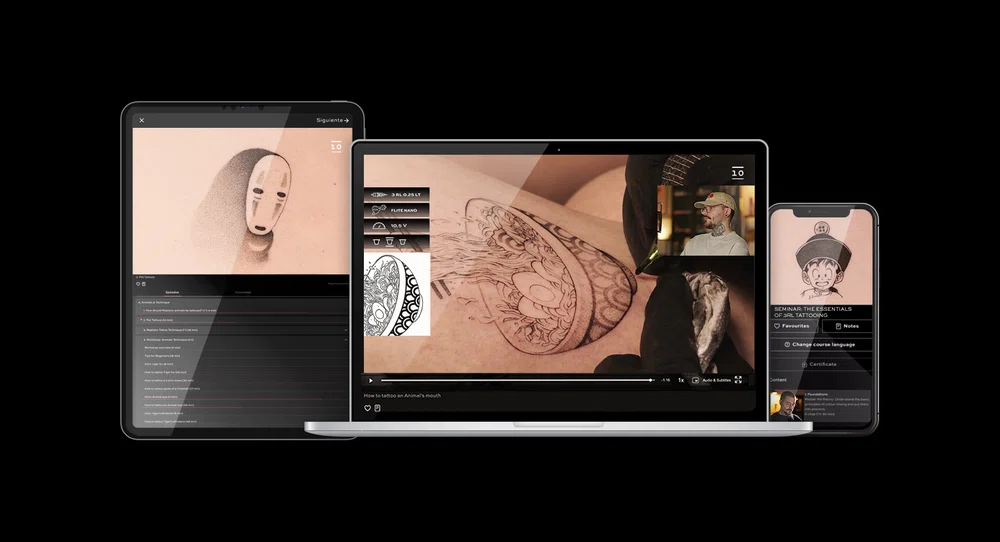We’ve all wondered the same when starting: What tattoo needle should I use?
Today, we’re bringing you the ultimate guide to understanding the different types of tattoo needles, getting familiar with their various configurations, and learning what each one is used for.
We’ll break down the essential terminology you should know to easily identify needles and while analyzing their unique characteristics and differences.
→ Starting with Grouping
→ Moving on to Diameter
→ And wrapping up with Taper
By the end of this article, you’ll have a much clearer idea of which needle to use in each situation—and, more importantly, to avoid damaging your client’s skin or messing up the final result.
Let’s go!
In this article you'll learn about:
- Types of tattoo needles and their uses.
- Technical specs: grouping, diameter, and taper.
- Differences between traditional needles and cartridges.
- Tips for choosing your tattoo needles.
Tattoo Needle Grouping
There are five types of needle groupings in tattooing, categorized by how the micro-needles are arranged. These are:
- Round Liner
- Round Shader
- Classic Magnum
- Curved Magnum
- Flat Magnum
Each needle grouping serves a different purpose. So, whatever you choose will depend on the tattooing technique you’re using and the effect you’re aiming for.
Let’s break down how they are and what they are for.
Round Liner Needles (RL)
The Round Liner is an absolute must-have—it’s the go-to needle for lining. In this grouping, the micro-needles are arranged in a tight, round formation with a pointed tip, making it perfect for tattooing crisp, solid lines.
This type of grouping typically ranges from 1 to 20 needles.
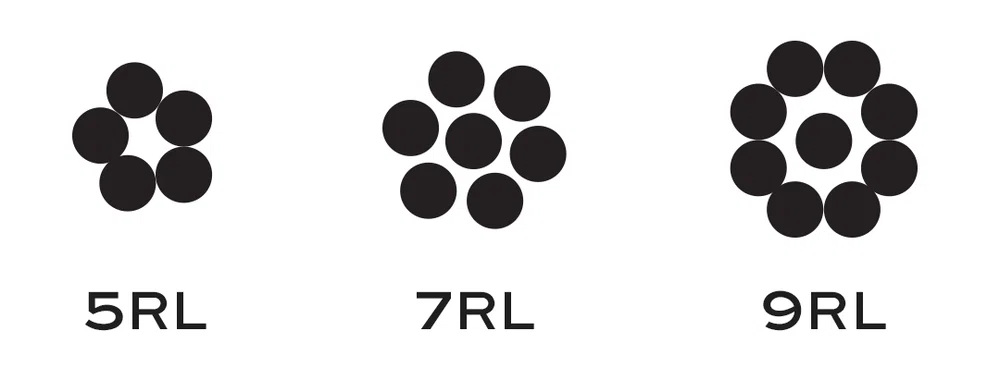
You may also like:
Round Shader Needles (RS)
With the Round Shader, we dive into the world of shading. Its arrangement is the same as the Round Liner, but the needle tips are more spaced apart. They’re perfect for shading small, detailed areas, and also work well for filling in small sections and adding details.
Round Shader groupings typically range from 3 to 30 needles.
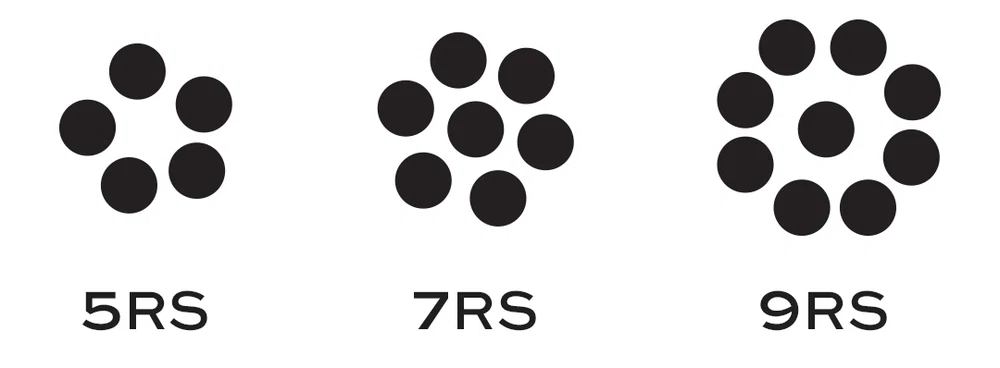
You may also like:
Magnum Needles (M)
The Magnum, also known as Magnum Classic or Regular Magnum, is a broader grouping consisting of two alternating rows of needles.
These are great for filling and shading larger areas, as the increased surface contact helps distribute pressure, allowing you to work on larger sections of skin without overworking the dermis.
This type of grouping can range from 5 to 49 needles.
PRO TIP: When using the Magnum, make sure to do it on its side. Placing it perpendicular to the skin can lead to overworking it and causing unnecessary damage.

You may also like:
Curved Magnum Needle (CM)
Also known as Round Magnum (RM), Soft Edge, or Soft Magnum, the Curved Magnum is very similar to the Classic Magnum. It has the same two-row needle setup and the same spacing between needles.
What makes it stand out is the unique curved design of the grouping. Also called "cat tongue" style, this needle allows you to create soft shading and filling effects without harshly defining the edges, resulting in a smoother finish—perfect for styles like Realism.
Just like the Classic Magnum, Curved Magnum groupings range from 5 to 49 needles.

Flat Magnum (F)
The Flat Magnum is arranged in a single line with closely spaced needles.
Thanks to its defined edges, it’s perfect for solid shading and creating geometric shapes.
This type of grouping typically ranges from 4 to 11 needles.

Round Shader or Magnum: Which grouping to choose?
Choosing the right needle grouping depends on your style and personal preferences.
When selecting the configuration you want to use, the first thing you need to consider is the distribution, since it’s closely linked to the technique you apply. Shading, filling, and lining are all very different.
The second thing to keep in mind is the number of needles in that grouping. This will also depend on each specific situation. It’s not the same to create a thick line as it is to make a fine one, nor is it the same to fill a small area as it is to fill a large one.
While there are general guidelines to follow, there’s no strict rule, and each artist picks what feels most comfortable for them.
Some tattooists prefer to avoid Round Shaders, while others can’t live without it. Similarly, some prefer the precision of the Flat Magnum, but others find the Curved Magnum gives them more control when approaching the line.
And this is before we even dive into essential factors like the body area or the client’s specific skin...
In the end, practicing the different tattoo techniques on synthetic skin will give you a broader vision of what works best for you as an artist. So, nothing like testing different configurations for the same purpose!
PRO TIP: Not sure whether to use Round Shader or Magnum? Try shading with both, pay attention to the feel in your hand, and analyze the differences in the results.
You may also like:
Tattoo Needle Diameter
The diameter of the tattoo needle determines how thick the micro-needles that make it up are. This doesn’t just affect the thickness of the line, but also how it behaves when entering the skin.
For example, thinner needles (gauge 08 - 10) allow for fine, detailed lines but require more precision with the angle and pressure to avoid the ink spreading or the needle overworking the skin.
On the other hand, thicker needles (gauge 12 or more) offer more stability and controlled penetration, making it easier to achieve both firm lines and smooth shading.
This also affects the soldering: thicker needles are typically more tightly packed together, making the needle work more straight and securely, which reduces the need to constantly adjust the angle.
For this terminology, there are two metric systems: the European and the North American.
Buying needles for the first time might seem a bit confusing since brands use different numbers for the same measurement, depending on where they are based. So, here's a conversion table to help you understand what each one is called in both systems.
| Gauge | Millimetres |
|---|---|
| 06 | 0,20mm |
| 08 | 0,25mm |
| 10 | 0,30mm |
| 12 | 0,35mm |
| 14 | 0,40mm |
| 16 | 0,45mm |
Tattoo Needle Taper
When we talk about Taper in a tattoo needle, we’re referring to the length of the bevel at the tip of each micro-needle, meaning, how sharp its soldering is. It’s crucial to know this terminology because it determines how the ink flows and how the needle penetrates the skin.
There are: Short Taper, Medium Taper, Long Taper, and Extra Long Taper.
- Short Taper (1.5-2.0 mm): Its thicker tip makes it release more ink. Perfect for solid fillings, color packing, and thick lines.
- Medium Taper (2.5-3.5 mm): The middle ground between precision and ink flow. Perfect either for lines, shadings, or fillings. Its versatility makes it a favorite for many.
- Long Taper (5.0-7.0 mm): With a finer and sharper tip, it deposits less ink per impact, allowing for greater control and precision. Perfect for realism, details, and fine lines.
- Extra Long Taper (8.0+ mm): Very sharp and extremely long, it can penetrate the skin more smoothly, but you need to be careful not to overdo it. Great for fine details and subtle shading.
- There’s also Textured Taper: Its roughness allows it to hold more ink and create a more organic texture on the skin. It’s commonly used in styles like Black & Grey and for work that requires more ink saturation.
Which one to choose depends, once again, on your personal preferences, the techniques you apply, and your experience.
Remember to practice and experiment to figure out what works best for you. Synthetic skin will be your best friend ;).
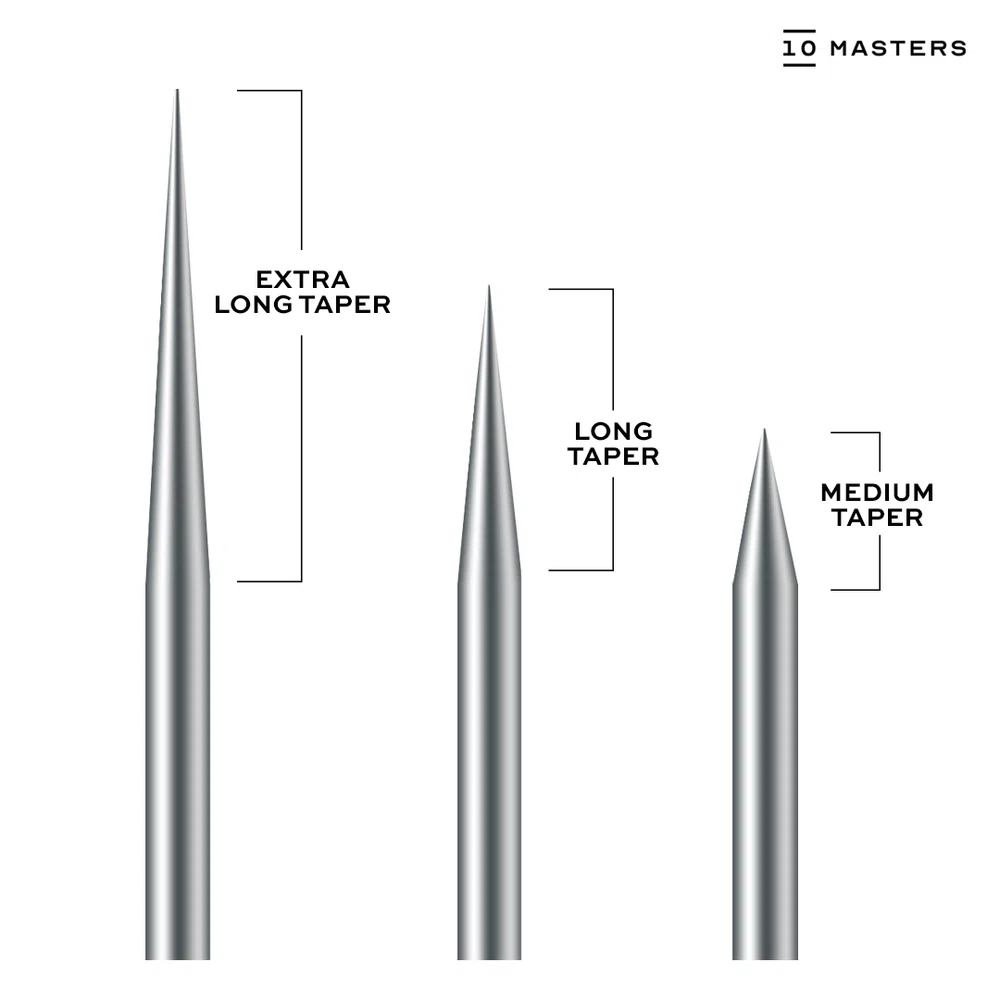
You may also like:
Tattoo Needle Configuration
The needle configuration refers to the full classification of all the nomenclature we've been discussing. It's how they are identified on the packaging, and it's crucial that you learn how to read it to understand exactly what needle you're dealing with.
Let's break it down with an example…
Here, we're dealing with a Round Liner made up of 9 needles with a 0.35 diameter and a medium taper.
Traditional Needles vs. Cartridges: Which One to Choose?
Understanding the difference between traditional tattoo needles and cartridges is also key when choosing which one to work with.
Traditional Needles
This system has been used for decades and consists of a needle welded to a metal rod, which is mounted on the grip and rests on the machine's rubber. They're more common in coil machines, but can also be used in some hybrid rotaries.
- They need to be manually assembled with the tip and the rod.
- They offer a "firmer" feel on the skin due to their structure.
- They require more experience for proper setup and calibration.
Cartridge Needles
In 2007, Cheyenne revolutionized the tattoo industry with this type of needle. It's a system where the needle and the tip are integrated into a single disposable piece, compatible with any machine. Primarily used in rotary and pen-style machines, though there are adapters available for coil machines.
- They're faster and easier to change, streamlining the tattooing process.
- Equipped with safety membranes to prevent cross-contamination.
- No manual calibration required, as they simply insert directly into the grip.
The latest addition to the system is a capillary with a reservoir at the tip of the cartridge, allowing for up to 10 times more ink flow, reducing the frequency of dipping the needle to gather ink.
It also includes a guide for better visibility and increased precision while tattooing, regardless of the direction of the line. To top it all off, they also improve ink distribution, allowing for longer lines and solid fillings without overworking the skin.
Luckily for you, thanks to technological advancements in recent decades, the tattoo industry has made huge strides in equipment and materials. And that's just for starters! Specialized brands continue to innovate every year, so stay tuned and ALWAYS keep up to date.
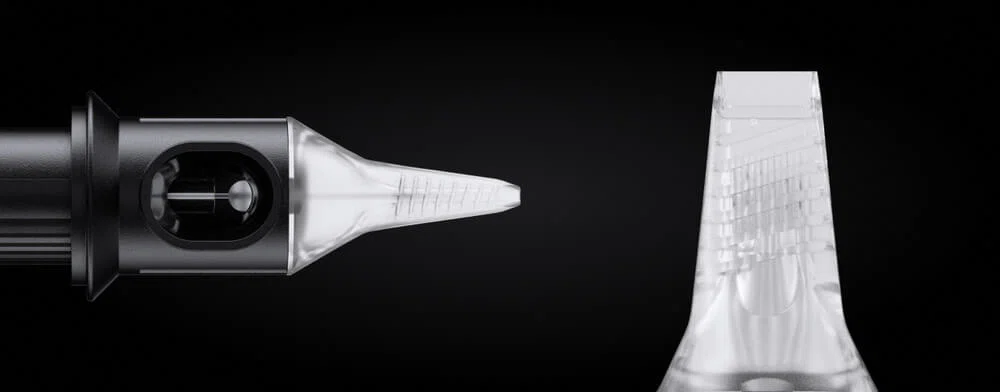
As for what to choose, again, it’s entirely up to you.
These days, many people start tattooing with rotary machines and cartridge needles because they’re practical, safe, and hygienic. But no one’s stopping you from starting with coil machines if that’s what you want. And for that, learning how to handle traditional needles would definitely become handy.
In the end, it will always be your style and technique that define what gear and setup to use. And if you haven't make up your mind yet, versatility and ease of use will always be your best bet.
What Needle to Use for Tattooing?
Knowing all the different types of tattoo needles is key to knowing what to pick because first, because you need to get familiar with each one’s features and recommended uses first
So, you can start by saving this guide for later! ;)
Now, if you're eager to know what needles should be in your first tattoo kit, you’ll need more than just a simple article, as there are tons of factors to consider, from personal style preferences to external variants like the client's skin and the body area being tattooed.
This, like everything in tattooing, you’ll figure it out by doing.
It’s through practice that you’ll settle on your favorite needle set. Meanwhile, you can try out versatile and easy-to-use configurations that let you work on lines, shading, and filling without overcomplicating things with specialized needles.
Your first needles must be stable and easy to control; ideally, medium-to-thick diameters (0.30 mm - 0.35 mm) for more tolerance on angle and pressure.
For example, 5RL and 7RL needles are usually great for lines and details without being too aggressive. For softer shading and fillings, you could try 7RS and 9RS. And if you want to cover larger areas, you can start with easy-to-handle standard Magnums like 7M1, 9M1, and 9RM.
And that’s it! With that basic set, you could start practicing on synthetic skin… But first, you’ll need to learn the basic tattooing techniques.
How do I tattoo crisp lines without overdoing them and causing blowouts? How do I move my hand to make even fillings and avoid a patchy look? How do I achieve smooth shadings that stand the test of time?
If this is just a small piece of all the doubts that hit you when thinking about starting to tattoo, or if you already tattoo but have run into some mistakes and have no f*cking idea how to fix them...
...Then you might find it helpful to learn the best tips and tricks from tattoo pros who have been around long enough to know what works and what definitely doesn't.
10 Masters Professional Tattoo Courses: the perfect dose of theory, technique, and practice you've been needing to skyrocket your tattoo skills.
